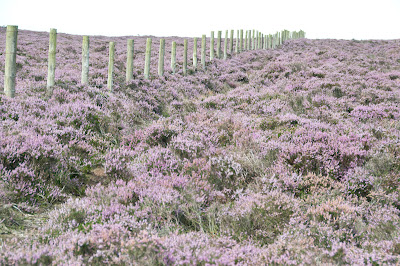Starting with the easy one – Red and Green can be found everywhere. In this case it’s our apple tree.
The red – green ratio is about 1 : 1 and the colour looks pretty well balanced. The dimensions of the apple fit comfortably within the green of the leaves, so this defined ratio seems to work.
For the orange – blue combination it’s off to the harbour again.
This boat with its bright mooring fenders was the final image I came up with. With the sun directly behind me the colours were really strong. The reflections enhance the image. This 1:2 orange: blue ratio seems to work well too.
The sketch was interesting in that the blues and yellows took up so little of the actual colours – the main constituent was black! There was a significant amount of brown too.
With the heather blooming on the moors this seemed to be the logical place to find the yellow: violet combination.
This clump of ragwort growing in the heather was just what I was looking for. It was quite windy so I had to use a fast shutter speed, with the consequent wide aperture and loss of depth of field, but I’m still happy with the result. The ragwort stands out from the heather, so maybe the 1:3 yellow: violet ratio is a bit off in this case. It may be because of the bright sunlight which has given more vibrancy to the yellow. It does still have a pleasing colour balance.
For the second part of the exercise I’ve used the garden, where the plants are those that among their other attributes have been chosen for their colours.
Yellow / Green
These grasses, taken with the sun behind them have produced what I think are a very pleasing image. The colours are adjacent on the colour wheel. I find the image really vibrant. The overall feeling is one of warmth – probably because of the high percentage of the bright yellow, which overcomes the cooler green.
Blue / Yellow
Again the colours in this Hydrangea are not complementary, but still work well. The colours are pastel, which helps to blend them together better. Having two colours from opposite sides of the ‘warm / cool’ sections of the wheel may help. I would have thought that the green in the background, combined with the blue of the flower would have created an image with an overall ‘cool’ feel, but the yellow in the image must have warmed it.
Violet / Green
This combination of colours has resulted in an image which radiates ‘warmth’. How that can have happened with colours which are predominantly ‘cool’ surprises me. It could be due to the obviously bright sunlight, or the warm whites in the image. There’s also a pleasant colour balance here - Maybe it’s the pinkness of the ‘violet’ that works with the green, but I would have thought it violet / green overall. The pastel shades of the flowers blend together with the green background easily. I really like this image - you can almost smell them.
Orange, blue, violet, green
I enticed the fly to this cornflower by placing a little honey placed in the centre of the flower, which enabled setting up the macro lens on a tripod and waiting for the fly to arrive.
There are combinations of complementary colours in this image:
- Red of the fly’s eyes with the green of the background.
- Blue of the outer petals with the orange of the fly’s abdomen.
- Violet of the inner petals with the hint of yellow from the honey.
The ratios of the colours don’t comply with those suggested by Von Goethe, but I find the image exciting. The mixture of colours and particularly the ‘zing’ of the green make this image ‘shout’
The sketch was different - I used it as a way to try out different watercolour methods – in this case Letraset water-based Promarkers along with the Inktense and water soluble sketching washes. I don't think my sketches will ever sell, but I'm enjoying them. It's surprising how much can be learned about an image this way.
So while there is some merit in using the suggested ratios of primary and secondary colours, it’s obviously not a hard and fast rule to follow. Neither is it necessary to always use complementary colours. At the end of the day, beauty is in the eye of the beholder and what works for one may not necessarily work for another.
It’s yet another aspect of composition which needs to be considered when framing the image. One which I find more exciting than any of those studied so far.




























